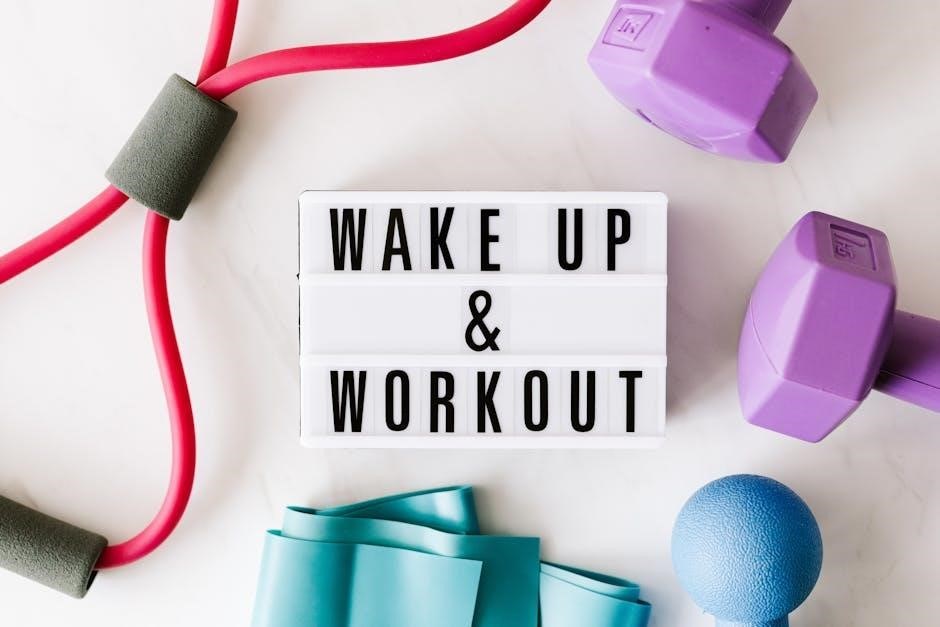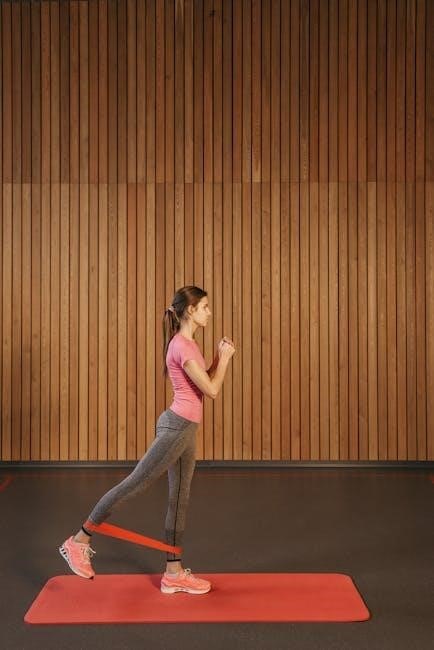Resistance bands are portable, versatile, and joint-friendly tools offering a full-body workout anywhere․ They’re ideal for strength training, mobility, and rehabilitation, making them perfect for home exercises․
1․1 What Are Resistance Bands?
Resistance bands are lightweight, durable straps or tubes designed to provide tension for strength training․ They come in various forms, including loop bands, tube bands with handles, and flat sheets․ Available in multiple resistance levels, they cater to all fitness levels, from beginners to advanced․ Portable and cost-effective, resistance bands are ideal for home workouts, travel, or rehabilitation․ They offer consistent resistance throughout movements, making them versatile for targeting specific muscle groups and improving overall mobility and strength․
1․2 Versatility of Resistance Band Training
Resistance band training offers unmatched versatility, enabling users to target every major muscle group․ Whether focusing on upper body, lower body, or core, bands can be anchored, looped, or held in various ways to adapt exercises․ This flexibility allows for a wide range of movements, from chest presses to squats, and even mobility drills․ Their portability makes them ideal for workouts at home, in the gym, or while traveling․ Additionally, bands provide progressive resistance, making them suitable for all fitness levels, from rehabilitation to advanced strength training․

Benefits of Using Resistance Bands
Resistance bands are portable, cost-effective, and joint-friendly, offering a convenient way to strength train anywhere․ They provide versatile workouts for all fitness levels, enhancing mobility and flexibility․
2․1 Portability and Convenience
Resistance bands are ultra-lightweight and compact, making them easy to carry in a gym bag or suitcase․ Their small size allows for workouts in any location, whether at home, in a hotel, or outdoors․ This convenience is ideal for maintaining fitness routines while traveling or when space is limited․ They require minimal storage and can be used anywhere, offering flexibility and accessibility for consistent training․ Their portability ensures you never miss a workout, regardless of your location or available space․
2․2 Cost-Effectiveness
Resistance bands are an affordable and economical option for strength training․ They are significantly cheaper than gym memberships or heavy equipment, making them accessible to everyone․ Their durability ensures long-term use, providing excellent value for money․ With a single set, you can perform a wide variety of exercises targeting multiple muscle groups․ This eliminates the need for expensive machinery or weights, making resistance bands a cost-effective solution for home workouts․ They are also easy to replace, offering a budget-friendly way to maintain a consistent fitness routine without financial strain․
2․3 Joint-Friendly Exercise Option
Resistance bands are a joint-friendly alternative to traditional weightlifting, reducing stress on joints and minimizing injury risk․ They provide controlled tension throughout exercises, promoting smooth movements that are easier on the body; This makes them ideal for individuals with joint pain or those recovering from injuries․ The flexibility of resistance bands allows for natural muscle engagement without the heavy impact associated with free weights, offering a safer and more comfortable workout experience for all fitness levels․
Choosing the Right Resistance Band
Selecting the right resistance band involves considering types, such as loop or tube bands, and choosing appropriate tension levels to match your fitness goals and strength level․
3․1 Types of Resistance Bands
Resistance bands come in various styles, including loop bands, tube bands with handles, figure-8 bands, and mini bands․ Loop bands are versatile for full-body exercises, while tube bands offer greater control․ Figure-8 bands provide variable resistance, ideal for strength training․ Mini bands are perfect for lower-body and core workouts․ Each type caters to different fitness goals, making them suitable for beginners and advanced users alike․ Choosing the right style ensures effective and safe workouts tailored to your needs;
3․2 Selecting the Appropriate Tension Level
Selecting the right tension level is crucial for effective and safe resistance band workouts․ Lighter bands are ideal for beginners or rehabilitation, while heavier bands suit advanced users․ Consider your fitness goals and muscle groups being targeted․ Start with lower resistance to focus on form and gradually increase as strength improves․ Proper tension ensures optimal muscle engagement without strain, helping to achieve desired results efficiently․ Always test the band’s resistance before starting exercises to avoid injury and maximize effectiveness․

Full-Body Resistance Band Exercises
Resistance bands offer versatile full-body workouts that engage multiple muscle groups, enhancing strength, flexibility, and overall fitness․ Ideal for conditioning at home or on the go․
4․1 Upper Body Exercises
Resistance bands are excellent for targeting the upper body, including chest, shoulders, and arms․ Popular exercises include bicep curls, tricep extensions, and shoulder presses․ For bicep curls, stand on the band with feet shoulder-width apart, hold the handles with palms forward, and curl toward shoulders․ Tricep extensions involve anchoring the band overhead and extending arms․ Shoulder presses strengthen deltoids by pressing the band upward․ Chest flys work the pecs by spreading arms with the band․ These exercises build strength, improve posture, and enhance muscle definition when performed consistently․
4․2 Lower Body Exercises
Resistance bands effectively target the lower body, enhancing strength and flexibility․ Squats involve standing on the band, holding handles at shoulder height, and performing deep squats․ Lateral band walks strengthen hip muscles by stepping sideways with a band around thighs․ Hamstring curls and donkey kickbacks isolate the posterior chain․ Glute bridges with bands add resistance for a stronger glutes workout․ These exercises improve balance, boost muscle tone, and are ideal for full-body or split routines, ensuring comprehensive lower body development with minimal equipment․
4․3 Core Strengthening Exercises
Resistance bands are excellent for targeting the core, improving stability and posture․ Exercises like banded Russian twists, plank rows, and bicycle crunchs engage the abdominals and obliques․ Anchoring the band overhead for leg raises or using it for pallof presses enhances rotational strength․ These movements strengthen the entire core, boosting balance and overall athletic performance․ They are versatile, allowing for varying resistance levels to suit different fitness goals, making them a key component of a well-rounded workout routine focused on core development and functional strength․

Structuring Your Workout Routine
Structure your resistance band workout with a clear plan, starting with warm-ups, then progressing through full-body or split routines․ Incorporate rest periods and adjust resistance as you advance․
5․1 Warm-Up and Preparation
A proper warm-up is essential before starting any resistance band workout․ Begin with dynamic stretches to increase blood flow and flexibility․ Incorporate light resistance band mobility exercises to prepare your muscles․ Focus on movements that target major muscle groups, such as arm circles, leg swings, and torso twists․ Additionally, perform a few minutes of aerobic exercises, like jumping jacks or high knees, to elevate your heart rate․ This preparation ensures your body is ready for the workout, reducing the risk of injury and improving overall performance․
5․2 Sample 12-Week Workout Program
This structured 12-week program is designed to progressively build strength and endurance․ Weeks 1-4 focus on full-body workouts, targeting all major muscle groups․ Weeks 5-8 transition to an upper/lower split, allowing for more intense training․ Weeks 9-12 adopt a push/pull/legs split for advanced muscle development․ Each phase includes dynamic warm-ups and mobility exercises․ Rest periods are kept short to maximize efficiency․ Progression is achieved by increasing reps, resistance, or intensity, ensuring continuous improvement throughout the program․

Progression and Increasing Difficulty
Progression involves adjusting resistance levels, increasing reps, or adding exercise variations․ This ensures continued muscle engagement and avoids plateaus, keeping workouts challenging and effective․
6․1 Adjusting Resistance Levels
Adjusting resistance levels is crucial for progressive overload․ Start with lighter bands to master form, then gradually switch to thicker, heavier bands as strength improves․ This ensures consistent muscle challenge and avoids plateaus․ Incorporating multiple bands or layering them can also increase tension․ Proper progression helps build strength and muscle effectively, keeping workouts engaging and results-oriented over time․ Always choose bands that align with your current fitness level to maximize efficiency and safety․
6․2 Incorporating Variation in Exercises
Incorporating variation in exercises keeps workouts engaging and targets different muscle groups․ Modify movements by changing angles, grips, or band placement to add diversity․ For example, perform bicep curls with palms up or down, or adjust foot positioning in chest presses․ Combining exercises, like supersets or circuits, enhances intensity․ Variations prevent plateaus and ensure comprehensive muscle development․ Experimenting with new exercises regularly keeps routines fresh and challenging, promoting continuous progress and avoiding monotony in training․
Tracking Progress and Staying Motivated
Track your workouts with a journal, noting exercises, reps, and resistance levels․ Celebrate milestones and set realistic goals to stay motivated and committed to your fitness journey․
7․1 Keeping a Workout Journal
A workout journal is a powerful tool for tracking progress and staying motivated․ By documenting each session, including exercises performed, resistance levels, and repetitions, you can monitor improvements over time․ This helps identify strengths, areas for growth, and ensures consistency․ Additionally, noting how you feel physically and mentally after each workout provides insights into your overall well-being․ Over time, this data becomes a valuable resource for adjusting your routine and celebrating achievements, keeping you focused and driven toward your fitness goals․
7․2 Setting Realistic Goals
Setting realistic goals is essential for maintaining motivation and tracking progress․ Start by defining specific, measurable objectives, such as increasing the number of repetitions or moving to a higher resistance level․ Break larger goals into smaller, achievable milestones to avoid discouragement․ Celebrate each accomplishment, no matter how small, to stay motivated․ Align your goals with your fitness journey, ensuring they are challenging yet attainable․ Regularly reviewing and adjusting these goals helps maintain focus and ensures continued growth in your resistance band workout routine․
Resistance bands are a portable, versatile, and joint-friendly tool for full-body workouts․ They enhance strength, mobility, and rehabilitation․ Consistent use leads to improved overall fitness and well-being․
8․1 Final Tips for Success
Consistency is key to achieving results with resistance bands․ Always warm up before workouts and gradually increase resistance levels․ Track your progress in a journal to stay motivated․ Incorporate variations in exercises to avoid plateaus and keep routines engaging․ Focus on proper form to maximize effectiveness and prevent injury․ Stay committed, and you’ll enjoy improved strength, flexibility, and overall fitness․ Resistance bands are a convenient and effective tool for long-term success in your fitness journey․

